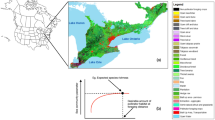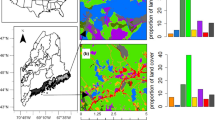Abstract
Context
Bees are the most important pollinators of crops worldwide. For most bees, patches of semi-natural habitat within or adjacent to crops can provide important nesting and food resources. Despite this, land cover change is rapidly reducing the abundance of semi-natural habitat within agroecological landscapes, with potentially negative consequences for bee communities and the services they provide.
Objectives
Identify how the availability of semi-natural habitat impacts bee communities across biogeographic regions, which may reveal commonalities and key governing principles that transcend a single region or taxa.
Methods
We analyze and compare the drivers of bee community composition in cotton fields within Brazil and the U.S. to reveal how land cover and land cover change impact bee community composition across these two regions.
Results
We show that the most critical factors impacting bee communities in cotton agroecosystems are the same in Brazil and the U.S.: bee abundance increases with cotton bloom density and the abundance of semi-natural habitat. Further, the loss of semi-natural habitat over a 5-year period negatively impacts bee abundance in both agroecosystems.
Conclusions
Given the importance of bee abundance for the provision of pollination service in cotton plants, our findings highlight the significance of small semi-natural habitat fragments in supporting key ecosystem service providers for both tropical and temperate cotton agroecological systems. We underscore the important role that local land managers play in biodiversity conservation, and the potential contribution they can make to pollination provision by supporting agricultural landscapes that conserve fragments of semi-natural habitat.



Similar content being viewed by others
References
Alvarez EC, Plocheck R (2014) Texas Almanac 2014–2015. Texas State Historical Association. http://www.estremolembo.com/texas-almanac-2012-150-2013-english.pdf. Accessed 29 Aug 2017
Anderson MJ (2001) A new method for non-parametric multivariate analysis of variance. Austral Ecol 26:32–46
Arino O, Perez JJR, Kalogirou V, Bontemps S, Defourny P, Van Bogaert E (2012) Global land cover map for 2009. ESA & UCL
Ashman TL, Knight TM, Steets JA, Amarasekare P, Burd M, Campbell DR, Morgan MT (2004) Pollen limitation of plant reproduction: ecological and evolutionary causes and consequences. Ecology 85:2408–2421
Barton K (2016) multi-model inference. R package version 1.15. 6. 2016
Bates D, Mächler M, Bolker B, Walker S (2014) Fitting linear mixed-effects models using lme4. arXiv preprint arXiv:1406.5823
Benton TG, Vickery JA, Wilson JD (2003) Farmland biodiversity: is habitat heterogeneity the key? Trends Ecol Evol 18:182–188
Biesmeijer JC, Roberts SP, Reemer M, Ohlemüller R, Edwards M, Peeters T, Settele J (2006) Parallel declines in pollinators and insect-pollinated plants in Britain and the Netherlands. Science 313:351–354
Bommarco R, Lindborg R, Marini L, Öckinger E (2014) Extinction debt for plants and flower-visiting insects in landscapes with contrasting land use history. Divers Distrib 20:591–599
Brosi BJ, Daily GC, Shih TM, Oviedo F, Durán G (2008) The effects of forest fragmentation on bee communities in tropical countryside. J Appl Ecol 45:773–783
Burnham KP, Anderson DR (2003) Model selection and multimodel inference: a practical information-theoretic approach. Springer, Fort Collins
Cane JH, Minckley RL, Kervin LJ, Roulston TAH, Williams NM (2006) Complex responses within a desert bee guild (Hymenoptera: Apiformes) to urban habitat fragmentation. Ecol Appl 16:632–644
Chao A, Chazdon RL, Colwell RK, Shen TJ (2005) A new statistical approach for assessing similarity of species composition with incidence and abundance data. Ecol Lett 8:148–159
Conner WH, Day JW, Baumann RH, Randall JM (1989) Influence of hurricanes on coastal ecosystems along the northern Gulf of Mexico. Wetl Ecol Manag 1:45–56
Cusser S, Neff JL, Jha S (2015) Land use change and pollinator extinction debt in exurban landscapes. Insect Conserv Divers 8:562–572
Cusser S, Neff JL, Jha S (2016) Natural land cover drives pollinator abundance and richness, leading to reductions in pollen limitation in cotton agroecosystems. Agric Ecosyst Environ 226:33–42
Garibaldi LA, Steffan-Dewenter I, Kremen C, Morales JM, Bommarco R, Cunningham SA, Carvalheiro LG, Chacoff NP, Dudenhöffer JH, Greenleaf SS, Holzschuh A (2011) Stability of pollination services decreases with isolation from natural areas despite honey bee visits. Ecol Lett 14:1062–1072
Ghazoul J (2005) Buzziness as usual? Questioning the global pollination crisis. Trends Ecol Evol 20:367–373
Ghazoul J (2006) Floral diversity and the facilitation of pollination. J Ecol 94:295–304
Goulson D (2000) Why do pollinators visit proportionally fewer flowers in large patches? Oikos 91:485–492
Goulson D, Nicholls E, Botías C, Rotheray EL (2015) Bee declines driven by combined stress from parasites, pesticides, and lack of flowers. Science 347:1255957
Grando C, Amon ND, Clough SJ, Guo N, Wei W, Azevedo P, López-Uribe MM, Zucchi MI (2018) Two colors, one species: the case of melissodes nigroaenea (Apidae: Eucerini), an important pollinator of cotton fields in Brazil. Sociobiology 65:645–653
Greenleaf SS, Williams NM, Winfree R, Kremen C (2007) Bee foraging ranges and their relationship to body size. Oecol 153:589–596
Grime JP (1998) Benefits of plant diversity to ecosystems: immediate, filter and founder effects. J Ecol 86:902–910
Han W, Yang Z, Di L, Mueller R (2014) CropScape: a Web service based application for exploring and disseminating US conterminous geospatial cropland data products for decision support. Comput Electron Agric 84:111–123
Hanski I, Ovaskainen O (2002) Extinction debt at extinction threshold. Conserv Biol 16:666–673
Hegland SJ, Boeke L (2006) Relationships between the density and diversity of floral resources and flower visitor activity in a temperate grassland community. Ecol Entomol 31:532–538
Hegland SJ, Grytnes JA, Totland Ø (2009) The relative importance of positive and negative interactions for pollinator attraction in a plant community. Ecol Res 24:929–936
Helm A, Hanski I, Partel M (2006) Slow response of plant species richness to habitat loss and fragmentation. Ecol Lett 9:72–77
Jha S, Vandermeer JH (2009) Contrasting bee foraging in response to resource scale and local habitat management. Oikos 118:1174–1180
Kearns CA, Oliveras DM (2009) Environmental factors affecting bee diversity in urban and remote grassland plots in Boulder. Colorado J Insect Conserv 13:655–665
Kearns CA, Inouye DW, Waser NM (1998) Endangered mutualisms: the conservation of plant-pollinator interactions. Annu Rev Ecol Evol Syst 29:83–112
Kleijn D, Winfree R, Bartomeus I, Carvalheiro LG, Henry M, Isaacs R, Klein AM, Kremen C, M’gonigle LK, Rader R, Ricketts TH (2015) Delivery of crop pollination services is an insufficient argument for wild pollinator conservation. Nat Commun 6:7414
Klein AM, Vaissière BE, Cane JH, Steffan-Dewenter I, Cunningham SA, Kremen C, Tscharntke T (2007) Importance of pollinators in changing landscapes for world crops. Proc R Soc Lond 274:303–313
Krauss J, Bommarco R, Guardiola M, Heikkinen RK, Helm A, Kuussaari M, Steffan Dewenter I (2010) Habitat fragmentation causes immediate and time delayed biodiversity loss at different trophic levels. Ecol Lett 13:597–605
Kruess A, Tscharntke T (2002) Grazing intensity and the diversity of grasshoppers, butterflies, and trap-nesting bees and wasps. Conserv Biol 16:1570–1580
Kunin WE (1993) Sex and the single mustard: population density and pollinator behavior effects on seed-set. Ecology 74:2145–2160
Mato Grosso Institute of Agricultural Economics (2014). http://www.imea.com.br/imea-site/. Accessed in 12 Oct 2017
McGregor SE (1976) Insect pollination of cultivated crop plants. Agricultural Research Service, US Department of Agriculture, Washington, DC
Michener CD (2007) The bees of the world. JHU Press, Baltimore
Myster RW (2016) The physical structure of forests in the Amazon basin: a review. Bot Rev 82:407–427
Nabhan GP, Buchmann SL (1997) Services provided by pollinators. In: Daily GC (ed) Nature’s Services: societal dependence on natural ecosystems. Island Press, Washington, DC, pp 133–150
Naimi B (2013) usdm: Uncertainty analysis for species distribution models. R package version 1.1-12
O’brien RM (2007) A caution regarding rules of thumb for variance inflation factors. Qual Quant 41:673–690
Oksanen J, Kindt R, Legendre P, O’Hara B, Stevens MHH, Oksanen MJ (2007) The vegan package. Commun Ecol Package 10:631–637
Ollerton J, Winfree R, Tarrant S (2011) How many flowering plants are pollinated by animals? Oikos 120:321–326
Pedro SRM (2014) The stingless bee fauna in Brazil (Hymenoptera: Apidae). Sociobiology 61:348–354
Perfecto I, Vandermeer J (2008) Spatial pattern and ecological process in the coffee agroforestry system. Ecology 89:915–920
Pires VCP, Silveira FA, Sujii ER, Torezani KR, Rodrigues WA, de Albuquerque FA, Rodrigues SM, Salomão AN, Pires CS (2014) Importance of bee pollination for cotton production in conventional and organic farms in Brazil. J Poll Ecol 13:151–160
Pope N, Jha S (2018) Seasonal food scarcity prompts long-distance foraging by a wild social bee. Am Nat 191:45–57
Potts SG, Vulliamy B, Roberts S, O’Toole C, Dafni A, Ne’eman G, Willmer P (2005) Role of nesting resources in organising diverse bee communities in a Mediterranean landscape. Ecol Entomol 30:78–85
Potts SG, Biesmeijer JC, Kremen C, Neumann P, Schweiger O, Kunin WE (2010) Global pollinator declines: trends, impacts and drivers. Trends Ecol Evol 25:345–353
QGIS Development Team (2017) QGIS Geographic Information System. Open Source Geospatial Foundation Project. http://qgis.osgeo.org
Ratter JA, Ribeiro JF, Bridgewater S (1997) The Brazilian Cerrado vegetation and threads to its biodiversity. Ann Bot 80:223–230
Ricketts TH, Regetz J, Steffan-Dewenter I, Cunningham SA, Kremen C, Bogdanski A, Gemmill-Herren B, Greenleaf SS, Klein AM, Mayfield MM, Morandin LA, Ochieng A, Viana BF (2008) Landscape effects on crop pollination services: are there general patterns? Eco Lett 11:499–515
Roubik DW (1980) Foraging behavior of competing Africanized honeybees and stingless bees. Ecology 61:836–845
Sang A, Teder T, Helm A, Pärtel M (2010) Indirect evidence for an extinction debt of grassland butterflies half century after habitat loss. Biol Cons 143:1405–1413
Scialabba NH, Williamson D (2004) The scope of organic agriculture, sustainable forest management and ecoforestry in protected area management. FAO, Rome
Thuiller W, Albert C, Araujo MB, Berry PM, Cabeza M, Guisan A, Sykes MT (2008) Predicting global change impacts on plant species’ distributions: future challenges. Perspect Plant Ecol Syst 9:137–152
Tscharntke T, Klein AM, Kruess A, Steffan-Dewenter I, Thies C (2005) Landscape perspectives on agricultural intensification and biodiversity–ecosystem service management. Ecol Lett 8:857–874
Tylianakis JM, Klein AM, Tscharntke T (2005) Spatiotemporal variation in the diversity of Hymenoptera across a tropical habitat gradient. Ecology 86:3296–3302
Tylianakis JM, Didham RK, Bascompte J, Wardle DA (2008) Global change and species interactions in terrestrial ecosystems. Ecol Lett 11:1351–1363
Vázquez DP, Morris WF, Jordano P (2005) Interaction frequency as a surrogate for the total effect of animal mutualists on plants. Ecol Lett 8:1088–1094
Veddeler D, Klein AM, Tscharntke T (2006) Contrasting responses of bee communities to coffee flowering at different spatial scales. Oikos 112:594–601
Waser NM (1983) The adaptive nature of floral traits: ideas and evidence. Pollinat Biol 1:241–285
Xie Z, Williams PH, Tang Y (2008) The effect of grazing on bumblebees in the high rangelands of the eastern Tibetan Plateau of Sichuan. Insect Conserv Divers 12:695–703
Acknowledgements
Special thanks to the growers and landowners that allowed us to sample on their lands; without them none of this work would have been possible. For sampling and research permits in Brazil, we thank Chico Mendes Institute for Biodiversity Conservation (ICMBio). This research was supported by the São Paulo Research Foundation (FAPESP—2014/50738-9), The National Council for Scientific and Technological Development (CNPq—310446/2015-5), and the Coordination for the Improvement of Higher Education Personnel CAPES- Programa Biologia Computacional (CAPES-1572813). In the U.S., the help of Texas Agricultural & Mining extension agents, crop consultants, and The Welder Wildlife Foundation, including Roy Parker, Stephen Biles, Lee Hutchins Jr., Kenneth Hanslik, and Terry Blankenship, was invaluable. Thanks to the Jha lab for helpful feedback and support, as well as help in the field from Nicole Vojnovich, Alan Ritchie Jr., Sarah Cunningham, and Rebecca Ruppel. Funding in Texas was provided by the Texas Parks and Wildlife Department, the Army Research Office, and the National Science Foundation.
Author information
Authors and Affiliations
Corresponding author
Additional information
Publisher's Note
Springer Nature remains neutral with regard to jurisdictional claims in published maps and institutional affiliations.
Electronic supplementary material
Below is the link to the electronic supplementary material.
Rights and permissions
About this article
Cite this article
Cusser, S., Grando, C., Zucchi, M.I. et al. Small but critical: semi-natural habitat fragments promote bee abundance in cotton agroecosystems across both Brazil and the United States. Landscape Ecol 34, 1825–1836 (2019). https://doi.org/10.1007/s10980-019-00868-x
Received:
Accepted:
Published:
Issue Date:
DOI: https://doi.org/10.1007/s10980-019-00868-x




